Menus
- Two cruisers in comparison
- The cruisers in comparison
- Wellbeing point goes to the Yamaha
- Yamaha takes Harley off for almost two seconds
- Sportster – this term arouses false expectations?
- Engine, transmission, brakes
- transmission
- Brakes
- Conclusion
- Yamaha XV 950
- Price comparison of the Harley Davidson Sportster 883 Iron and the Yamaha XV 950
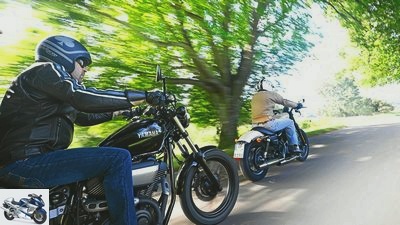
Gargolov
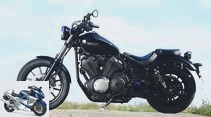
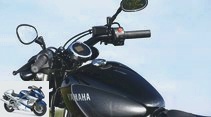
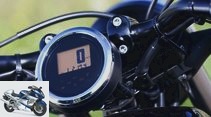
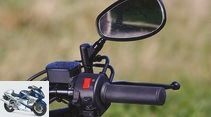
34 photos

Gargolov
1/34
Both cruisers aim high. Which bike is more convincing??
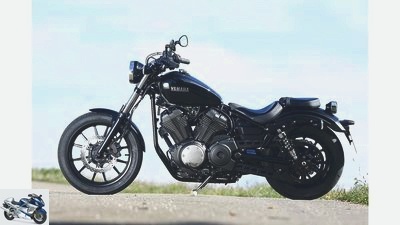
Gargolov
2/34
The point for the feel-good effect clearly goes to the Japanese.
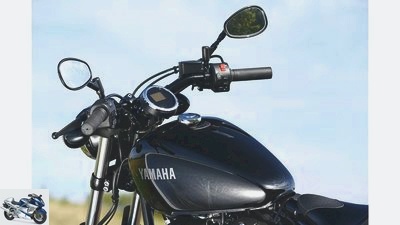
Gargolov
3/34
The Yamaha XV 950 is 500 euros cheaper than the Harley.

Gargolov
4/34
Modern in the ceramic hob style, but difficult to read: information such as flashing, neutral or the tank warning light is difficult to see in sunlight.
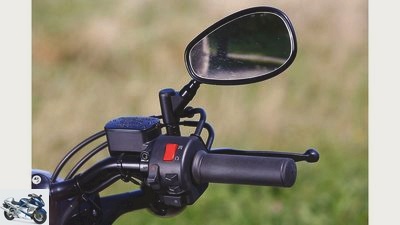
Gargolov
5/34
Plasticine, fiddly and haptically not as successful as with the American competition: In Japan, narrow switches with suboptimal pressure points are used.
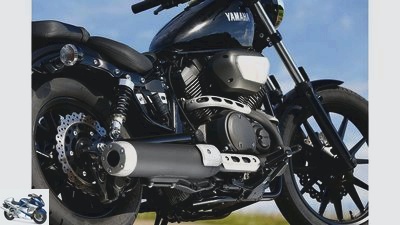
Gargolov
6/34
The Japanese woman’s two-cylinder, four-stroke, 60-degree V engine.
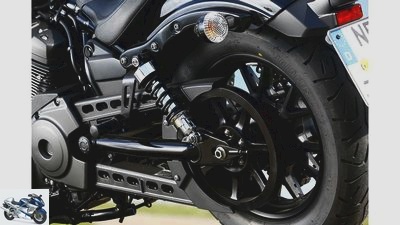
Gargolov
7/34
This is precisely where the Yamaha brakes fail, the pressure point of which is spongy and moves when braking hard – sometimes the hand lever can be pulled almost to the handlebars.
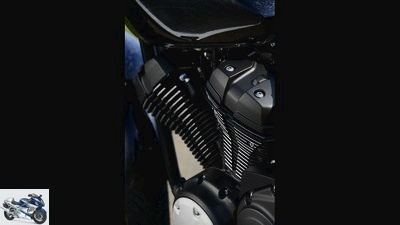
Gargolov
8/34
The cooling fins are beautifully displayed. Plastic covers serve as cylinder head covers, which look cheap. With a displacement of 942 cubic meters, the 60-degree V2 is superior to the American competition by 60 cubic meters.
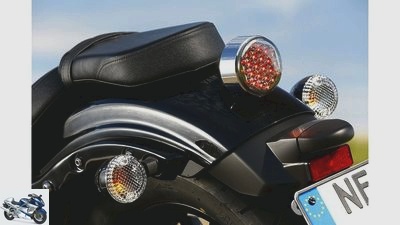
Gargolov
9/34
The rear fenders of both models are made of steel and have an almost identical shape. Yamaha relies on a centrally mounted rear light with hexagonal light-emitting diodes.
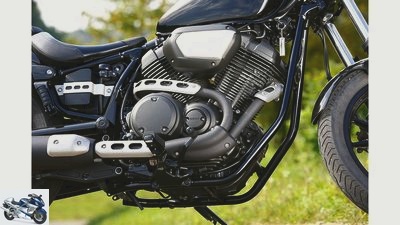
Gargolov
10/34
The Yamaha XV 950 has an output of 52 hp.
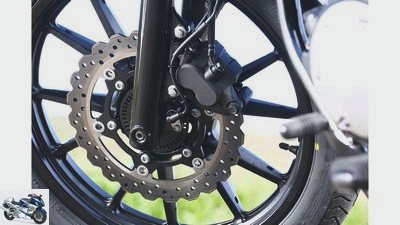
Gargolov
11/34
Copy and paste? You could almost think if you look at the spoked wheels. The difference: With the Yamaha, they are hollow, Harley has milled off the sides, which looks a bit more elegant.
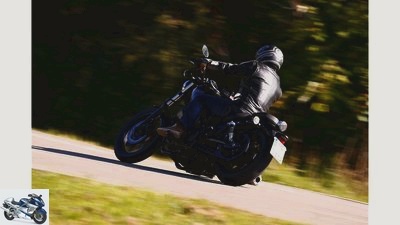
Gargolov
12/34
The performance characteristics of the Yamaha V2 tempt you to shift up early when driving.
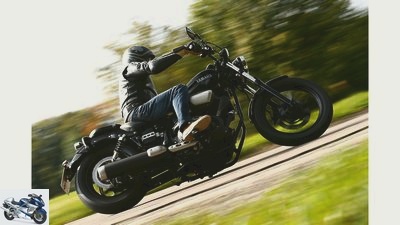
Gargolov
13/34
Yamaha’s four-valve technology, the increased displacement and perhaps also an optimally successful engine management help the XV 950 to considerably more pressure in the cellar.
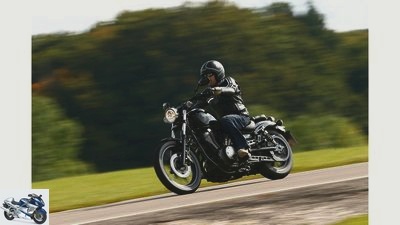
Gargolov
14/34
The Yamaha behaves much more neutrally when flipping and drives very precisely.
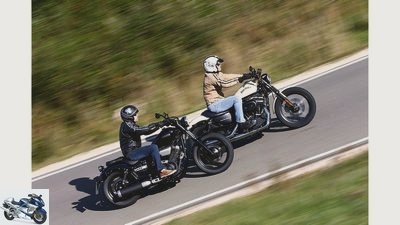
Gargolov
15/34
When pulling through in fifth and last gear, the Yamaha reduces the Harley from 100 to 140 km / h for almost two seconds, although it has a longer gear ratio.
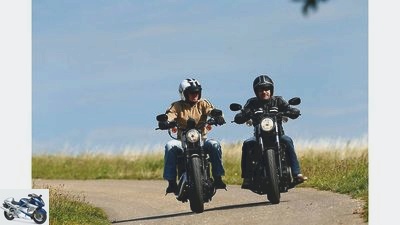
Gargolov
16/34
Aiming high: Both bikes target newcomers and those returning to the sport. It’s a shame that the Yamaha is not offered ex works in a 48 hp version like the Harley.

Gargolov
17/34
On the Yamaha XV 950 you sit deeper and more relaxed.

Gargolov
18/34
As soon as you reach the country road or motorway, the measured values come into focus.
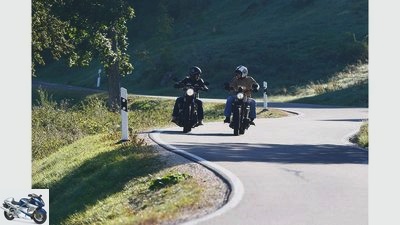
Gargolov
19/34
“You’re shaking! Damn cold, right? ”
“Nah, the engine vibrates like that.”

Gargolov
20/34
The Harley-Davidson Sportster 883 Iron finds a respectable sale without superlatives: From January to August 2013 the Iron was sold 571 times over German sales counters.

Gargolov
21/34
The seat height of the Harley is very low at 750 millimeters.
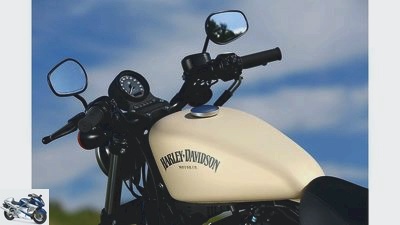
Gargolov
22/34
When driving, the US twin transmits noticeable vibrations to the handlebars between 2800 and 3200 rpm. Above and below they are much lower, they could well be described as Good Vibrations or Character.
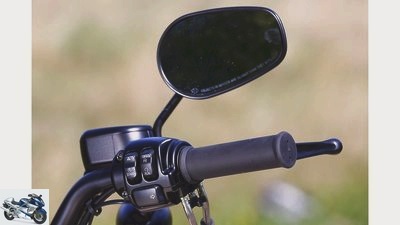
Gargolov
23/34
The switch unit from the USA looks more stable, valuable and massive. The Iron, Harley’s entry-level model, also has an automatic turn signal reset.
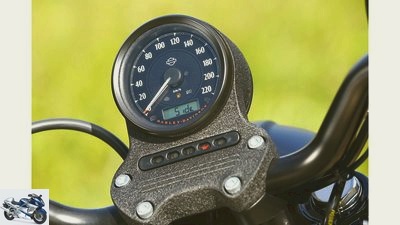
Gargolov
24/34
Classic and easy to read. In addition, the following information can be called up on the small digital display: two day trips, total kilometers, time as well as gear display and speed.
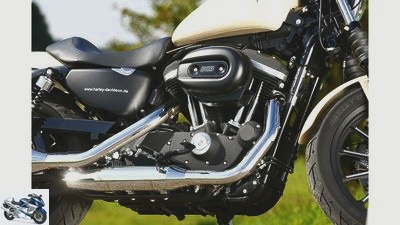
Gargolov
25/34
The Harley’s two-cylinder four-stroke 45-degree V engine.
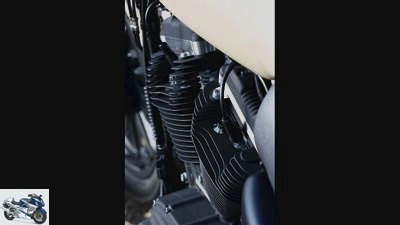
Gargolov
26/34
The Sportster drive looks archaic compared to the modern Japanese. You can like that. In the relevant engine-specific disciplines such as power development, smoothness, pulling power and acceleration, it is left behind compared to the Yamaha.
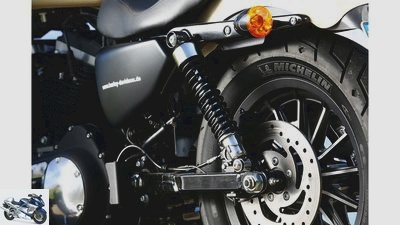
Gargolov
27/34
The Americans installed new brake calipers, and the brake disc diameter of the front brake grew to 300 mm.
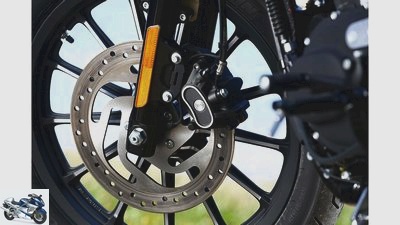
Gargolov
28/34
Both bikes are equipped with ABS. While the Yamaha has it on board as standard, it is only available from Harley for an additional charge of 500 euros.
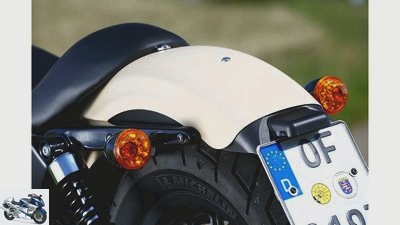
Gargolov
29/34
Both brake and rear lights are integrated in the indicators. The clean look of the Harley invites you to mount the license plate on the side. A two-person bench is available as an accessory.
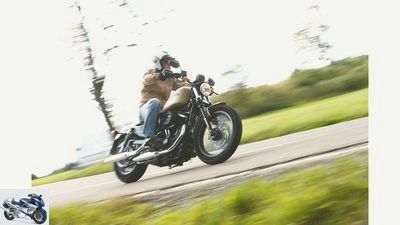
Gargolov
30/34
Sportster – this term ends up raising false expectations?
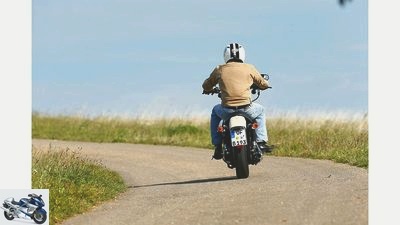
Gargolov
31/34
With the Harley, the so-called fear nipples – in street jargon – put on early. That is harmless. Even if you unscrew it, nothing happens for a long time.
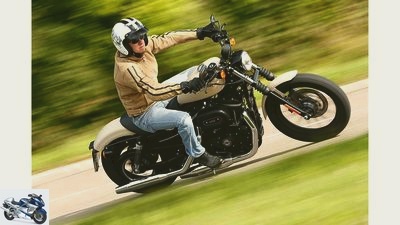
Gargolov
32/34
The Harley lifts 55 hp at 5900 rpm. In terms of technical data, the Harley is the sportier of the two.
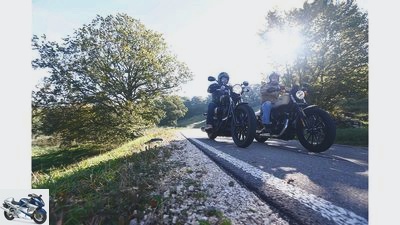
Gargolov
33/34
Motorcycles that are already fun to glide with pleasure are all the rage.
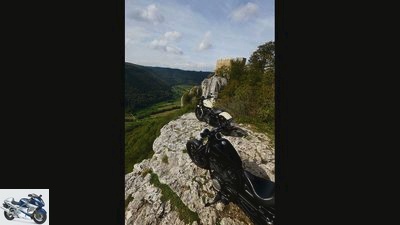
Gargolov
34/34
If you really want to ride a Harley and value stability, greater lean angle, better sound, more effective brakes (ABS version) and a cooler look, you don’t need to read any further. For everyone else, the 500 Euro cheaper Yamaha is recommended. Your V2 has more torque and runs more cultivated, it sits more snuggly on it, and the suspension setup is also more comfortable than that of the US bike.
Harley-Davidson Sportster 883 Iron and Yamaha XV 950 in the test
Two cruisers in comparison
A cruiser comparison test with the Harley-Davidson Sportster 883 Iron clarifies whether the new Yamaha XV 950 has what it takes to overtake.
The cruisers in comparison
Let’s dive into an upside-down world: this time, only just over 50 hp are available to propel five hundred pounds of weight. Wrong world? Yes! Because while the world of supersport bikes is currently about undercutting 190 kilograms and surpassing 200 hp, Harley is already offering this in its fifth year Harley-Davidson Sportster 883 Iron. The model from the Sportster series is selling well without superlatives: From January to August 2013, the Iron went over German sales counters 571 times. In the ranking, it marks the 35th place of all motorcycles sold in Germany. Ascending trend. Because motorcycles that are fun to glide with pleasure are right on trend.
Buy complete article
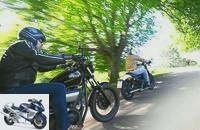
Harley-Davidson Sportster 883 Iron and Yamaha XV 950 in the test
Two cruisers in comparison
The Yamaha cruiser weighs five kilos less
Yamaha has recognized this and with the XV 950 has developed a motorcycle whose key data are almost identical to those of the Harley-Davidson Sportster 883 Iron: At 253 kilograms, the Yamaha weighs five kilograms less than the American. With 52 HP it has a nominal output of 1 HP less, and with a top speed of 163 km / h it is three kilometers per hour faster than the Iron.
In terms of price, too, the Japanese orientated themselves towards the American competition: at 8,595 euros it is just 20 euros more expensive than the Harley-Davidson Sportster 883 Iron without ABS. But since everyone would like to have this on board presumably for safety reasons and because of the higher resale value, an iron with ABS was ordered for this comparison test, which at 9075 euros is 480 euros more expensive than the Yamaha XV 950.
If you want to drive in pairs, you have to shell out at least 432 euros for stops and a larger bench seat on the Iron. Which, however, will not really put off interested parties. Because when you buy a Harley, money is always well invested. The 25 most stable motorcycles on the market include 23 Harley models. The loss in value of US bikes is comparatively small. A fact that potential buyers can take into account. But no more penny-pinching. The two main protagonists of this comparison are at the door with a full tank and have to reveal their strengths and weaknesses while driving.
Wellbeing point goes to the Yamaha
It starts with the first contact, when the Yamaha XV 950 looks more massive than the Harley due to its high front. Despite this optical impression, the seating position on the Japanese is ergonomically more favorable. Because you sit more relaxed on the 950. Your handlebars sit better in the hand, the footrests are more conveniently positioned. In direct comparison, the Harley imposes its will on the driver: the knee angle is narrower here, the handlebars do not lie so casually in the hand, and the shape of the seat is not particularly flattering because the rounded upholstery is uncomfortable. With a seat height of just 685 millimeters, the XV 950 is pleasantly low, and in conjunction with the narrow waist, even people under 1.60 meters can reach the floor safely. The seat height of the Harley-Davidson Sportster 883 Iron is also low at 750 millimeters, but the point for the feel-good effect clearly goes to the Japanese.
Gargolov
Aiming high: Both bikes target newcomers and those returning to the sport. It’s a shame that the Yamaha, like the Harley, is not offered ex works in a 48 hp version.
Enter the corridors, let’s go through the city traffic. When the sheet metal avalanches pierce through, the following is noticeable: The clutches of both bikes can be operated easily and without great effort, and you can see better in the mirrors of the Yamaha. However, the gearbox of the Harley shifts much harsher. The blow when first gear is engaged is powerful. Compared to the Yamaha XV 950, further gear changes require more emphasis. One thing should be noted here: neither of the two motorcycles deserves the rating “good” when shifting gears. Gentle gear changes with short distances and smooth engagement, which are made possible by almost all popular superbikes, are alien to the two character actors.
And something else is noticeable: When it comes to a quick traffic light start, the Harley is completely inferior to the Yamaha XV 950. The explanation for this is not due to the different skills of the two test drivers, but rather the MOTORRAD test bench provides: Yamaha’s 950 is already pushing properly at low speeds. The air-cooled 60-degree V2 already produces almost 70 Newton meters of torque at 2000 rpm, and it already serves its maximum value of 79 Nm at 3000 tours. For comparison: to provide its maximum 71 Nm, the air-cooled 45-degree V2 of the Harley needs 4800 rpm. It’s quite late. Because the US twin turns a maximum of 5900 rpm. But the test bench also reveals the maximum performance of the two Vau engines: the Harley-Davidson Sportster 883 Iron lifts 55 hp at 5900 rpm, the Yamaha leaves it at 53 hp at 5600 rpm. These values are of course insignificant in city traffic.
Yamaha takes Harley off for almost two seconds
As soon as you reach the country road or motorway, however, they come back into focus. Do you want to pay? When pulling through in fifth and last gear, the Yamaha XV 950 of the Harley-Davidson Sportster 883 Iron drops from 100 to 140 km / h for almost two seconds, although it has a longer gear ratio. Here, the older US engine design with four camshafts below that actuate two valves per cylinder via bumpers pays tribute to the newer concept from Japan. Because the Yamaha comes up with four valves per cylinder, which are operated via an overhead camshaft and rocker arm – also not high-tech.
But at least the Japanese managed to tune their engine better for cruising than the team from Milwaukee. The Japanese V2 responds more directly and energetically to gas commands than its phlegmatic rival. And it also shines with its smoother running, although it is rigidly screwed to the chassis and has no balance shaft. In terms of running culture, Harley’s little V2 is ambivalent. Since 2004, the engine has been trembling in a patented pushrod suspension, which is intended to contain vibrations, but also allows the engine to hop up and down at the traffic lights in such an inimitable way. When driving, the US twin transmits noticeable vibrations to the handlebars between 2800 and 3200 rpm. Above and below they are much lower, they could well be described as Good Vibrations or Character.
And that brings us to the difference. Exactly this kind of coarseness is a key to the sales success of the US bikes. Because the little V2 shakes, crunches, rattles, vibrates, wriggles and – lives. Somehow, it seems. One gets an idea of what goes on during combustion processes inside the cooling towers and the crank mechanism. Objectively speaking, the Yamaha drive can do everything better: is stronger, runs smoother, distributes less vibrations. The Harley fan would say: You experience more with the 883 on a tour of 100 kilometers. The Yamaha freak, however, gets out of the saddle more relaxed. Anyone who likes it! The keyword “experience” is also joined by the sound. With the Harley-Davidson Sportster 883 Iron it is quite acceptable, with the Yamaha XV 950 it is quieter than restrained. If you want more, you can use the range of accessories. While the market for the long-established Harley has more than 13 exhaust systems between 600 and 2000 euros in store, Yamaha offers a slip-on silencer for the XV 950 from the specialist Acrapovic. The delivery date and price have not yet been set.
Sportster – this term arouses false expectations?
All well and good. But what if you really want to drive the two bikes over the home route? Sportster – does this term ultimately raise false expectations? And has Yamaha found the right one for its XV 950 called Sport Heritage Bike? To find the answers, you have to go into the jungle of curves. In terms of technical data, the Harley is the sportier of the two. At 1510 millimeters it has a 60 millimeter shorter wheelbase, at 59 degrees the slightly steeper steering head angle, and ultimately its narrower rim does not spread the 150 mm rear tire as much as the wider rim of the Yamaha.
Gargolov
Yamaha’s four-valve technology, the increased displacement and perhaps also an optimally successful engine management help the XV 950 to considerably more pressure in the cellar.
Is it all just theory? Yes. The Yamaha XV 950 behaves much more neutrally and drives more precisely than the Harley-Davidson Sportster 883 Iron when turning and turning. This is a bit more manageable, but it steers more wobbly. Subtleties that you only notice when switching directly. After a few minutes in the saddle you have completely adjusted to the subtle peculiarities. However, the Yamaha makes a small faux pas: Due to the exhaust system to the right of the engine, the right footrest and its stable support are a little further out than the left. As a result, you land faster on the right than on the left. That wouldn’t be a big deal if the massive footrest carrier weren’t also attached. This unpleasant contact with the ground can be even more serious, because it leverages the load. With the Harley, the so-called fear nipples – in street jargon – put on early. That is harmless. Even if you unscrew it, nothing happens for a long time. The little girl from Milwaukee can be more weird than some drivers. So much for the athletic attributes.
Which undoubtedly also include the brakes. Here the Harley shines with the shorter braking distance when braking, a crisp pressure point on the hand lever and good controllability. This is exactly where the brake of the Yamaha XV 950 lacks, the pressure point of which is spongy and moves when braking hard – sometimes the hand lever can be pulled almost to the handlebars. With the Harley, the new brake calipers installed from 2014 as well as the larger front disc and the new ABS have a positive effect.
Gargolov
Motorcycles that are already fun to glide with pleasure are all the rage.
If the small Harley-Davidson Sportster 883 Iron were to be given a few millimeters more rear suspension travel, the machine would also be recommended for people with intervertebral disc problems. However, one must advise against this. Because the Harley struts are only able to protect the rider from hard knocks to a limited extent. No wonder: only a measly 41 millimeters of spring travel is available. It is almost impossible to adjust this matchbox-length path sensibly to solo and pillion rides. More suspension travel would be better here. The Yamaha struts have that. Although there is only 29 millimeters more travel available, this means that you dampen noticeably better. The chassis set-up of the Yamaha XV 950 was more comfortable.
At the end of the day, you have to look into the tank. It’s an astonished look because the Harley only consumes 3.7 liters of gasoline per 100 kilometers. The Yamaha XV 950 is even a tenth of a liter less. Class! And whether Yamaha’s XV 950 not only swims in the fairway of the Sportster, but is even in the fast lane, will ultimately determine the sales figures. In any case, it has what it takes in terms of technology and driving dynamics. It will be interesting to see what else Yamaha conjures up under the umbrella term Sport Heritage Bikes.
Engine, transmission, brakes
BILLION
The performance curve of the Harley-Davidson Sportster 883 Iron and Yamaha XV 950
The pressure is where you want it best: at low revs. Yamaha’s four-valve technology, the increased displacement and perhaps also an optimally successful engine management help the XV 950 to considerably more pressure in the cellar. It is of no use to the Harley-Davidson Sportster 883 Iron that its V2 ultimately produces 2 hp more in speed regions that cruiser fans would never want to get to anyway.
transmission
The Yamaha XV 950 has a slightly longer gear ratio in fourth and fifth gear. Since the top speed for both (Yamaha: 163 km / h; Harley: 160 km / h) is only reached in the fifth, this is not overdrive. The performance characteristics of the Yamaha V2 tempt you to shift up early when driving. The Harley drive, on the other hand, wants to be turned a little more. At 100 km / h in fifth gear, both engines turn 3300 rpm.
Brakes
The investments have paid off for Harley: From model year 2014, the Sportster models will be available with ABS. In addition, the Americans are installing new brake calipers, and the brake disc diameter of the front brake grew to 300 mm. In a direct comparison of the brakes, the Harley not only decelerates better, it also gives a safer feeling: the US brakes remain stable and provide good feedback. The Yamaha XV 950 is gummy and indifferent.
Conclusion




34 photos
Pictures: Harley-Davidson Sportster 883 Iron and Yamaha XV 950 in the test
To home page
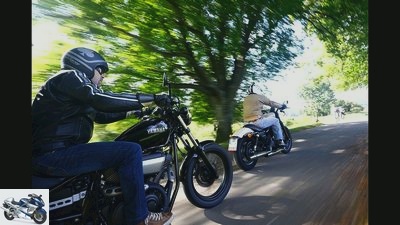
Gargolov
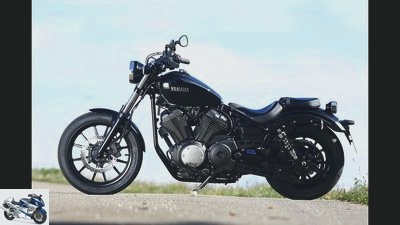
Gargolov

Gargolov
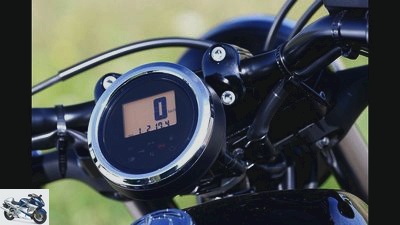
Gargolov
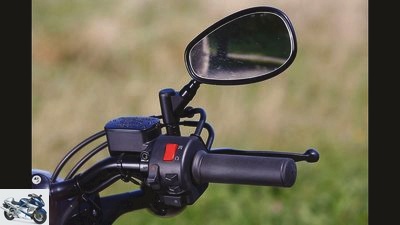
Gargolov
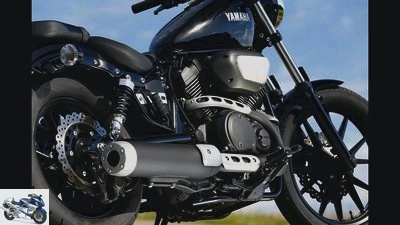
Gargolov
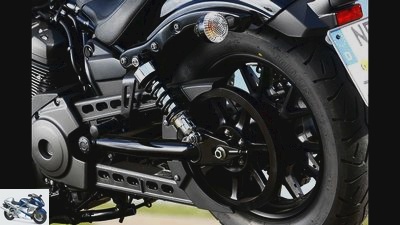
Gargolov
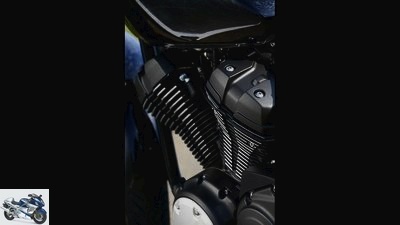
Gargolov
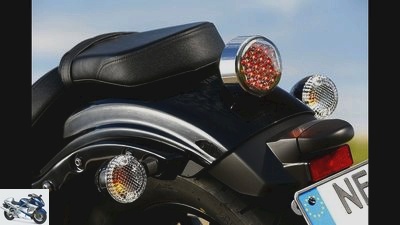
Gargolov
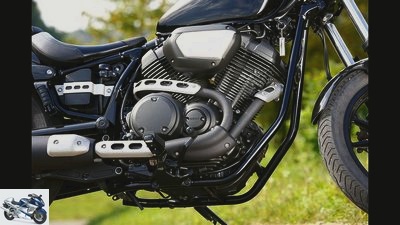
Gargolov
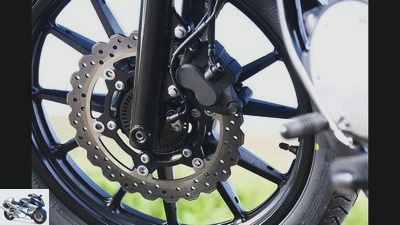
Gargolov

Gargolov
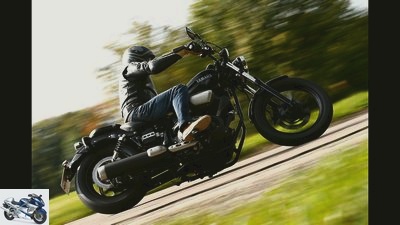
Gargolov
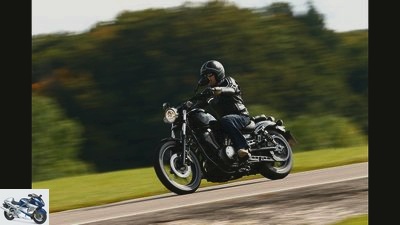
Gargolov
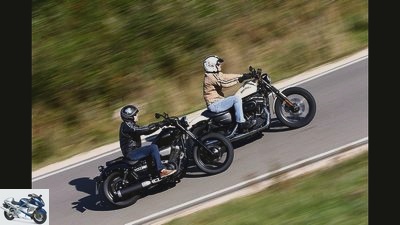
Gargolov
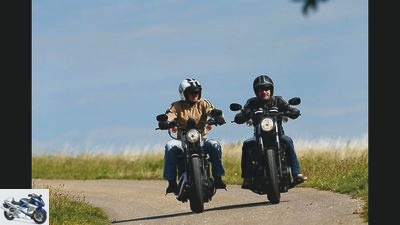
Gargolov
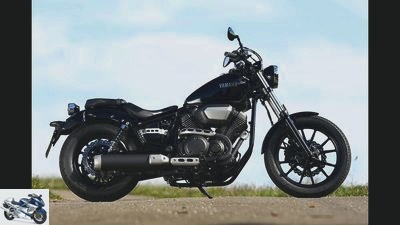
Gargolov
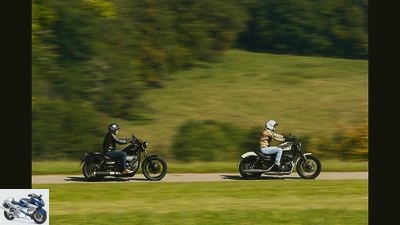
Gargolov
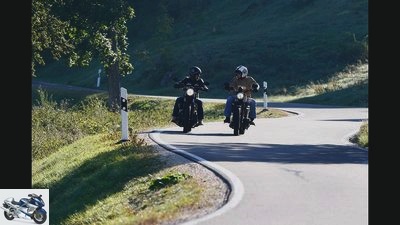
Gargolov
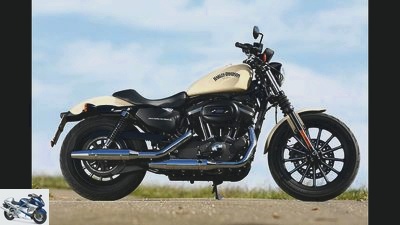
Gargolov

Gargolov

Gargolov
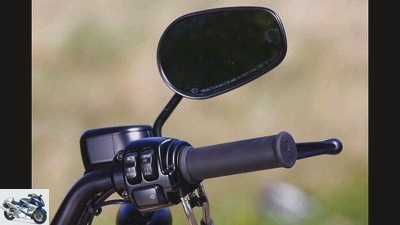
Gargolov
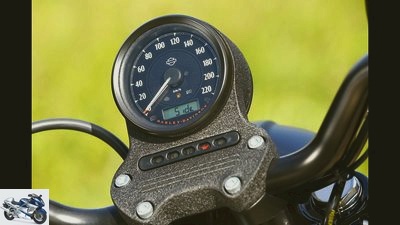
Gargolov
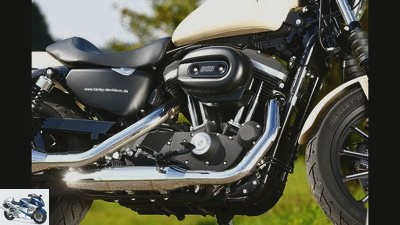
Gargolov

Gargolov
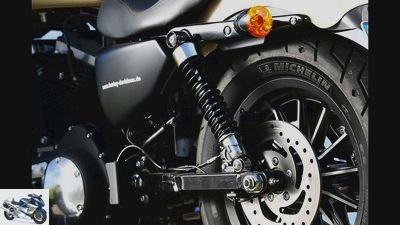
Gargolov
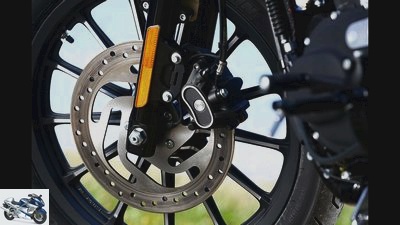
Gargolov
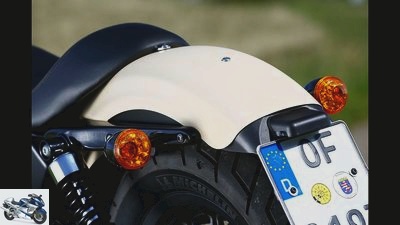
Gargolov
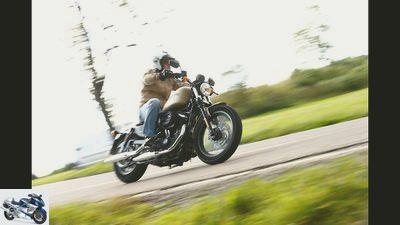
Gargolov
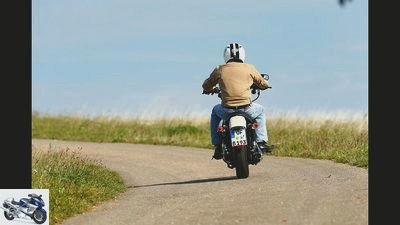
Gargolov
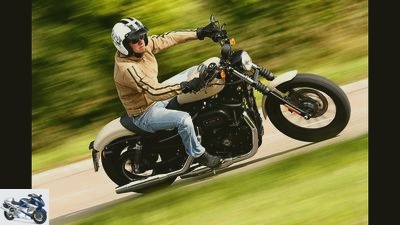
Gargolov
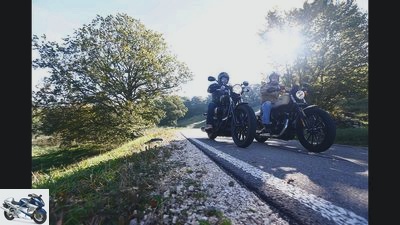
Gargolov

Gargolov
Harley-Davidson Sportster 883 Iron
Gargolov
The Harley-Davidson Sportster 883 Iron finds a respectable sale without superlatives: From January to August 2013 the Iron was sold 571 times over German sales counters.
engine
| design type | Two cylinder four stroke 45 degree V engine |
| injection | Ø 45 mm |
| coupling | Multi-disc oil bath clutch |
| Bore x stroke | 76.2 x 96.8 mm |
| Displacement | 883 cc |
| compression | 9: 1 |
| power | 39.0 kW (53 PS) at 5750 rpm |
| Torque | 70 Nm at 3750 rpm |
landing gear
| frame | Double loop frame made of steel |
| fork | Telescopic fork, Ø 39 mm |
| Brakes front / rear | Ø 300/260 mm |
| Assistance systems | ABS² |
| bikes | 2.50 x 19; 3.0 x 16 |
| tires | 100/90 B 19; 150/80 B 16 |
| Tires | Michelin Scorcher “31” |
measurements and weight
| wheelbase | 1510 mm |
| Steering head angle | 59.0 degrees |
| trailing | 117 mm |
| Front / rear suspension travel | 92/41 mm |
| Seat height ** | 750 mm |
| Weight with full tank ** | 258 kg |
| Payload ** | 196 kg |
| Tank capacity / reserve | 12.5 / 3.0 liters |
| Service intervals | 10000 km |
| price | 8,575 euros |
| Price test motorcycle | 9075 Euro² |
| Additional costs | 380 euros |
MOTORCYCLE readings
| Top speed * | 160 km / h |
| acceleration 0-100 km / h 0-140 km / h |
7.1 sec 14.5 sec |
| Draft 60-100 km / h 100-140 km / h |
7.5 sec 9.9 sec |
| Consumption highway | 3.7 liters / super |
| Reach country road | 338 km |
* Manufacturer information; ** MOTORCYCLE measurements; ²ABS 500 euros
Yamaha XV 950
Gargolov
The point for the feel-good effect clearly goes to the Japanese.
engine
| design type | Two cylinder four stroke 60 degree V engine |
| injection | Ø 35 mm |
| coupling | Multi-disc oil bath clutch |
| Bore x stroke | 85.0 x 83.0 mm |
| Displacement | 942 cc |
| compression | 9: 1 |
| power | 38.3 kW (52 hp) at 5500 rpm |
| Torque | 80 Nm at 3000 rpm |
landing gear
| frame | Double loop frame made of steel |
| fork | Telescopic fork, Ø 41 mm |
| Brakes front / rear | Ø 298/298 mm |
| Assistance systems | SECTION |
| bikes | 2.50 x 19; 4.50 x 16 |
| tires | 110 / 90-19; 150 / 80-16 |
| Tires | Bridgestone Exedra G721 / 722 |
measurements and weight
| wheelbase | 1570 mm |
| Steering head angle | 61.0 degrees |
| trailing | 130 mm |
| Front / rear suspension travel | 120/70 mm |
| Seat height ** | 685 mm |
| Weight with full tank ** | 253 kg |
| Payload ** | 235 kg |
| Tank capacity / reserve | 12.0 / – liters |
| Service intervals | 8000 km |
| price | 8595 euros |
| Price test motorcycle | 8595 euros |
| Additional costs | 200 euros |
MOTORCYCLE readings
| Top speed * | 163 km / h |
| acceleration 0-100 km / h 0-140 km / h |
6.0 sec 12.2 sec |
| Draft 60-100 km / h 100-140 km / h |
5.7 sec 8.0 sec |
| Consumption highway | 3.6 liters / normal |
| Reach country road | 333 km |
* Manufacturer information; ** MOTORCYCLE measurements; ²ABS 500 euros
Price comparison of the Harley Davidson Sportster 883 Iron and the Yamaha XV 950
Used Harley Davidson Sportster 883 Iron and Yamaha XV 950 in Germany
The two "small" Cruisers are ideal for leisurely two-wheelers, and also comparatively inexpensive for cruisers. Especially on the used motorcycle exchange you can find Harley Davidson Sportster 883 Iron and Yamaha XV 950 in top condition and at low prices: Used Harley Davidson Sportster 883 Iron and Yamaha XV 950 in Germany
Related articles
-
Comparison test muscle bikes Ducati Harley-Davidson Suzuki Yamaha
Gargolov 24 pictures Gargolov 1/24 The four muscle animals. Gargolov 2/24 Yamaha Vmax – Yes, that fits. The surge of combustion of the 200PS has to go through four …
-
35 pictures 1/35 picture gallery: Triumph Bonneville T100 Black, Moto Guzzi V9 Roamer and Harley-Davidson Sportster 883 Iron in …
-
Harley-Davidson Sportster Iron 883 and Harley-Davidson Street 750 in comparison test
www. 25th photos www. 1/25 Harley-Davidson wants to expand its fan base, the Harley-Davidson Street 750 is intended to inspire…
-
Endurance test final balance of the Yamaha YZF-R1
22 pictures Yamaha 1/22 Yamaha 2/22 Yamaha 3/22 Yamaha 4/22 Yamaha 5/22 Yamaha 6/22 Yamaha 7/22 Yamaha 8/22 Yamaha 9/22 Yamaha 10/22 Yamaha 11/22 Yamaha …
-
Harley-Davidson Sportster 1200 Custom, Indian Scout Sixty, Yamaha XVS 1300 A Midnight Star
www.bilski-fotografie.de 30th photos www.bilski-fotografie.de 1/30 Harley-Davidson Sportster 1200 Custom, Indian Scout Sixty and Yamaha XVS 1300 A…
-
Yamaha FJR 1300 Tourer in the test
fact 38 pictures fact 1/38 Yamaha FJR 1300 in the top test. fact 2/38 Yamaha FJR 1300 in the top test. fact 3/38 Yamaha FJR 1300 in the top test. fact 4/38 Yamaha FJR …
-
Harley-Davidson Sportster Iron 883 – Nightster 1200 in the test
Rivas Family duel: Harley-Davidson Sportster Iron 883 / Nightster 1200 Harley-Davidson cruiser in comparison test What is Harley driving? Is displacement…
-
Endurance test final balance of the Harley-Davidson Sportster XL 1200 CA
Arturo Rivas 34 pictures bilski-fotografie.de 1/34 Endurance test final balance of the Halrey-Davidson XL 1200 CA. Arturo Rivas 2/34 With all your senses: The XL …
-
Endurance test Harley-Davidson Sportster 1200 Sport
Endurance test Harley-Davidson Sportster 1200 Sport sharpening iron Almost three years of the Harley-Davidson Sportster 1200 Sport – an unusually long endurance test era …
-
Honda NC 700 S and Yamaha XJ6 ABS in the test
17 pictures 1/17 Honda NC 700 S and Yamaha XJ6 ABS in a 48 HP comparison test. 2/17 Honda NC 700 S and Yamaha XJ6 ABS …